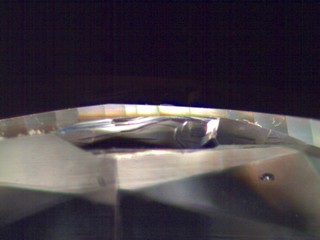A natural refers to a portion of the original rough diamond’s outer surface that remains unpolished on a finished, faceted diamond. This feature is intentionally left on the stone during the cutting and polishing process and is typically found along the girdle—the outer edge of the diamond that separates the crown (top) from the pavilion (bottom).
Why Are Naturals Left on a Diamond?
Maximizing Carat Weight
Diamond cutters aim to retain as much of the rough stone as possible. Removing all natural surfaces may require excessive cutting, reducing the final carat weight of the polished diamond.
Preserving Crystal Integrity
Some rough diamonds have growth lines or inclusions that, if cut away, could weaken the stone or impact its durability. Leaving a natural in a strategic area helps maintain the diamond’s overall strength.
Minimizing Waste
Since natural diamonds are rare and valuable, preserving part of the rough minimizes unnecessary loss of material during cutting.
Proof of Natural Origin
In some cases, gemologists and collectors appreciate naturals as evidence that the diamond was cut from a genuine rough stone rather than being lab-grown or heavily altered.
Impact on a Diamond’s Appearance and Quality
Polish Grade:
Naturals are considered minor surface features and are factored into the polish grade of a diamond. A diamond with significant naturals may receive a lower polish grade from gemological laboratories like DCLA, GIA, or AGS.
Location Matters:
If confined to the girdle area, naturals do not significantly affect the diamond’s overall appearance, brilliance, or value.
If present on the crown or table (top facets), they may be more visible and could impact the diamond’s aesthetic appeal.
Girdle Thickness Considerations:
Some naturals can contribute to an uneven girdle thickness, which might affect durability. A very thin girdle with a natural could increase the risk of chipping.
How to Identify a Natural in a Diamond?
Visible under Magnification
Naturals are typically small, textured, and may appear frosty or grainy under a jeweler’s loupe (10x magnification) or a microscope.
GIA & DCLA Reports
If a diamond has a natural, it is often noted in the grading report, usually under the clarity characteristics or polish comments section.
Naturals vs. Other Surface Features
Natural vs. Extra Facet:
A natural is an original rough diamond surface left untouched, while an extra facet is a man-made additional cut that is not part of the standard faceting pattern.
Natural vs. Cavity:
A natural is a minor surface remnant, whereas a cavity is an indentation or deeper surface flaw that can affect durability.
Are Naturals a Flaw?
Not necessarily. If located on the girdle, naturals are generally not a concern for beauty or durability. They do not impact the diamond’s brilliance or fire, and they are considered an acceptable feature in diamond cutting, especially for maximizing weight retention.
However, if a natural extends beyond the girdle onto visible facets, it could slightly affect the stone’s appearance and might be more noticeable.

